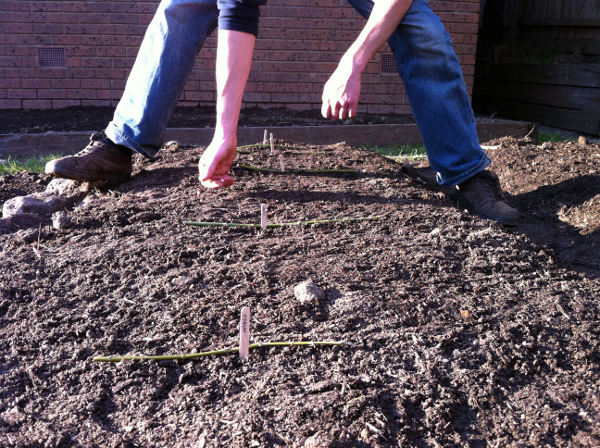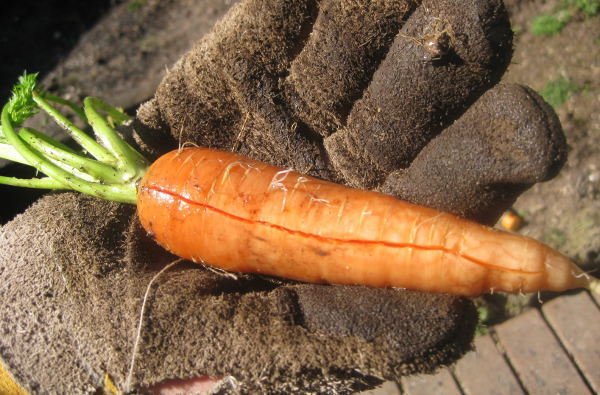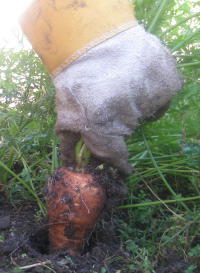Nothing beats freshly picked carrots from the garden. They are crunchy and sweet, and you have the choice of types and colours that you can’t get from a supermarket. Amaze your family and friends with salads and other dishes made with yellow, purple, white or red carrots as well as the ‘usual’ orange. You may not be aware but orange carrots are a relatively modern invention, carrots were originally purple or white.
Before you Plant your Seeds
Make sure you have a suitable place to grow your carrots. They need to be grown in full sun, and with well drained soil. Don’t fertilise the soil before planting as it will be too rich and the roots will become distorted but some very well rotted manure will be welcome if you dig it in a month before sowing your carrots.
Sowing your Seeds
Carrots need a deeply cultivated soil to grow to their best, dig down as far as your spade will allow as you turn over the soil. The seeds also need some sunlight to germinate so don’t sow them deeply, it is ok just to sow sparingly on the top of the soil, then just walk over them to press them to the soil. Now just lightly water and you are all done.
A few things to keep in mind:
- Don’t grow them in soil that gets waterlogged as they will rot as they grow. The soil needs to be well drained.
- Only sow them from late winter till early autumn. If you sow the seeds in late autumn or early winter they will bolt to seed as soon as the warm weather arrives in spring. The cold of winter gets them ready for bolting.
- Make sure your carrot patch is empty of weeds before sowing.
Cultivation
The great thing about growing your own carrots is that they are so easy to grow. They will tolerate most light soil types like sand to loam, and they don’t succumb to many diseases. Although they will grow quite happily on their own you will need to do some occasional work to get the best results.
The main job to keep an eye on is weeding. Carrots don’t compete well with weeds so pick any weeds out early.
Another way to get the best carrots is to thin them as they grow so they end up 10cm apart. This gives them room to grow to their full size. Thinnings can be eaten in stir-fries or just as they are. Remember that young carrot tops are edible and can be steamed and cooked like other greens.
Make sure you water them well once or twice a week in dry weather and you should be fine.
Pests and Problems
Luckily we don’t have a lot of carrot problems. Usually any problems you do have will be related to soil and watering.
- Forking roots - usually caused by heavy soil like clay or stony soil. With these soils it is better to grow shorter varieties.
- Splitting roots - This is a watering problem. Try to keep water constant as a heavy soaking while they are full grown will cause splitting.
- Tough cores - this is a problem of some of the older varieties when they are close to going to seed. Try to pick these when they are young.
- Small carrots - if you have planted seeds for a large variety but they are not growing, and their colour is pale this is usually caused by cold weather. They will grow a bit more when the weather warms up but keep an eye on them as they may bold at this time.
- Seedlings sown too thick - this is very easy to do. The best way to make sure your carrots have room to grow is to mix your carrot seed with an equal amount of clean sand and radish seed. Sow thinly then pick the radishes as they get to a good size. The radishes grow much quicker than the carrots so as you pick those, you leave room for the carrots to spread.
Harvest
Carrots are ready to harvest at any time you want. You can pull them when they are as small as your finger for sweet, baby carrots that are perfect for salads and eating raw, or you can wait till they are fully grown when they will be great for steaming, grating for carrot cakes, or any other use you want to put them to.
Carrots have to be one of the most satisfying crops to grow at home. You can grow a lot in a small area and they taste so good. It is fantastic to know that you can be self-sufficient, even in a small way, and able to provide your family with fresh food.









